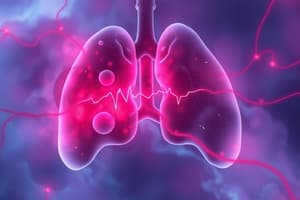Podcast
Questions and Answers
What is Hypoxic Hypoxia caused by?
What is Hypoxic Hypoxia caused by?
- Anemia or blood loss
- High altitude (correct)
- CO poisoning
- Hypoventilation (correct)
What are the blood gas values associated with Hypoxic Hypoxia?
What are the blood gas values associated with Hypoxic Hypoxia?
Decreased PaO2, Decreased SaO2, CaO2, Decreased PvO2
What causes Anemic Hypoxia?
What causes Anemic Hypoxia?
CO poisoning, Anemia or blood loss, Methemoglobinemia
What are the blood gas values associated with Anemic Hypoxia?
What are the blood gas values associated with Anemic Hypoxia?
What is Stagnant or Circulatory Hypoxia?
What is Stagnant or Circulatory Hypoxia?
What are some causes of Stagnant or Circulatory Hypoxia?
What are some causes of Stagnant or Circulatory Hypoxia?
What is Histotoxic Hypoxia?
What is Histotoxic Hypoxia?
What are the blood gas values associated with Histotoxic Hypoxia?
What are the blood gas values associated with Histotoxic Hypoxia?
How can Histotoxic Hypoxia be corrected?
How can Histotoxic Hypoxia be corrected?
What is Cyanosis?
What is Cyanosis?
What is Polycythemia?
What is Polycythemia?
Flashcards are hidden until you start studying
Study Notes
Hypoxic Hypoxia
- Caused by reduced oxygen (O2) in inspired air or decreased partial pressure of O2 in alveoli; may also include issues with O2 transfer to the bloodstream.
- Common causes include high altitude, hypoventilation, diffusion abnormalities, pulmonary shunting, and ventilation/perfusion (V/Q) mismatch.
- Blood gas values show decreased PaO2, SaO2, CaO2, and PvO2; correctable by increasing FiO2 and PEEP.
Anemic Hypoxia
- Characterized by abnormally low O2 content due to reduced hemoglobin (Hgb) or Hgb's inability to carry O2 effectively.
- Causes include carbon monoxide poisoning, anemia or blood loss, and methemoglobinemia.
- Blood gas values present normal PaO2 but decreased CaO2, PvO2, and SvO2; treatment includes increased FiO2 and packed red blood cells if Hgb is critically low.
Stagnant or Circulatory Hypoxia
- Results from decreased cardiac output or reduced circulation of oxygenated blood to tissues; elevated metabolic needs drive greater O2 extraction from the limited blood supply.
- Causes involve shock, hypovolemia, cardiac failure, and anatomical shunting; treatment may necessitate fluids, vasopressors, cardiac drugs, surgical repairs, and supplemental oxygen.
- Blood gas values reflect normal PaO2 and CaO2 but decreased DO2, PvO2, SvO2, and CvO2, coupled with increased arteriovenous oxygen difference (a-vDO2).
Histotoxic Hypoxia
- The inability of tissues to metabolize O2 adequately despite normal partial pressure and delivery; tied to cellular or mitochondrial dysfunction.
- Associated with sepsis (leading to mitochondrial damage) and cyanide poisoning (direct destruction of mitochondria).
- Initially normal arterial blood gas (ABG) readings; characterized by decreased O2 consumption, increased PvO2, SvO2, and CvO2 with diminished a-vDO2.
- Treatment focuses on maximizing oxygen delivery, managing sepsis with antibiotics, and stabilizing hemodynamic function.
Cyanosis
- Visual indication of low oxygen saturation characterized by blue-gray or purplish discoloration, particularly in mucus membranes and extremities.
- Occurs when blood contains more than 5g% hemoglobin that is disassociated from oxygen; calculated by example (Hb = 15g%, Sat% = 60; results in a cyanotic state).
Polycythemia
- Increased red blood cell (RBC) levels arise from chronic hypoxemia due to erythropoietin stimulation of bone marrow.
- Enhances oxygen-carrying capacity; however, hematocrit levels reaching 55-60% increase blood viscosity, posing work strain on the heart and resulting in left and right ventricle hypertrophy.
Studying That Suits You
Use AI to generate personalized quizzes and flashcards to suit your learning preferences.




